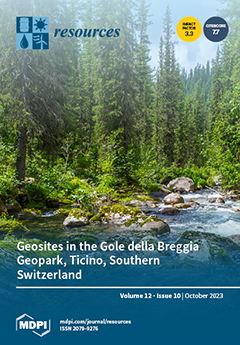Mackerel (
Auxis thazard), a tropical dark-fleshed fish, is currently a viable resource for the manufacture of surimi, but the optimal washing procedure for more efficient use of this particular species is required right away. Washing is the most critical stage in
[...] Read more.
Mackerel (
Auxis thazard), a tropical dark-fleshed fish, is currently a viable resource for the manufacture of surimi, but the optimal washing procedure for more efficient use of this particular species is required right away. Washing is the most critical stage in surimi production to ensure optimal gelation with odorless and colorless surimi. The goal of this study was to set a simple washing medium to the test for making mackerel surimi. Washing was performed three times with different media. T1 was washed with three cycles of cold carbonated water (CW). T2, T3, and T4 were washed once with cold CW containing 0.3%, 0.6%, or 0.9% NaCl, followed by two cycles of cold water. T5, T6, and T7 were produced for three cycles with CW containing 0.3%, 0.6%, or 0.9% NaCl. For comparison, unwashed mince (U) and conventional surimi washed three times in cold tap water (C) were employed. The maximum yield (62.27%) was obtained by washing with T1. When varying quantities of NaCl were mixed into the first washing medium (T2–T4), the yield decreased with increasing NaCl content (27.24–54.77%). When washing with NaCl for three cycles (T5–T7), the yield was greatly decreased (16.69–35.23%). Conventional surimi washing (C) produced a yield of roughly 40%, which was comparable to T3. Based on the results, treatments that produced lower yields than C were eliminated in order to maximize the use of fish resources and for commercial reasons. The maximum NaCl content in CW can be set at 0.6% only during the first washing cycle (T3). Because of the onset of optimal unfolding as reported by specific biochemical characteristics such as Ca
2+-ATPase activity (0.2 μmol inorganic phosphate/mg protein/min), reactive sulfhydryl group (3.61 mol/10
8 g protein), and hydrophobicity (64.02 µg of bromophenol blue bound), T3 washing resulted in surimi with the greatest gel strength (965 g.mm) and water holding capacity (~65%), with fine network structure visualized by scanning electron microscope. It also efficiently removed lipid (~80% reduction), myoglobin (~65% reduction), non-heme iron (~94% reduction), and trichloroacetic acid-soluble peptide (~52% reduction) contents, which improves whiteness (~45% improvement), reduces lipid oxidation (TBARS value < 0.5 mg malondialdehyde equivalent/kg), and decreases the intensity of the gel’s fishy odor (~30% reduction). As a result, washing mackerel surimi (
A. thazard) with CW containing 0.6% (
w/
v) NaCl in the first cycle, followed by two cycles of cold water washing (T3), can be a simple method for increasing gel-forming capability and oxidative stability. The mackerel surimi produced using this washing approach has a higher quality than that produced with regular washing. This straightforward method will enable the sustainable use of dark-fleshed fish for the production of surimi.
Full article





